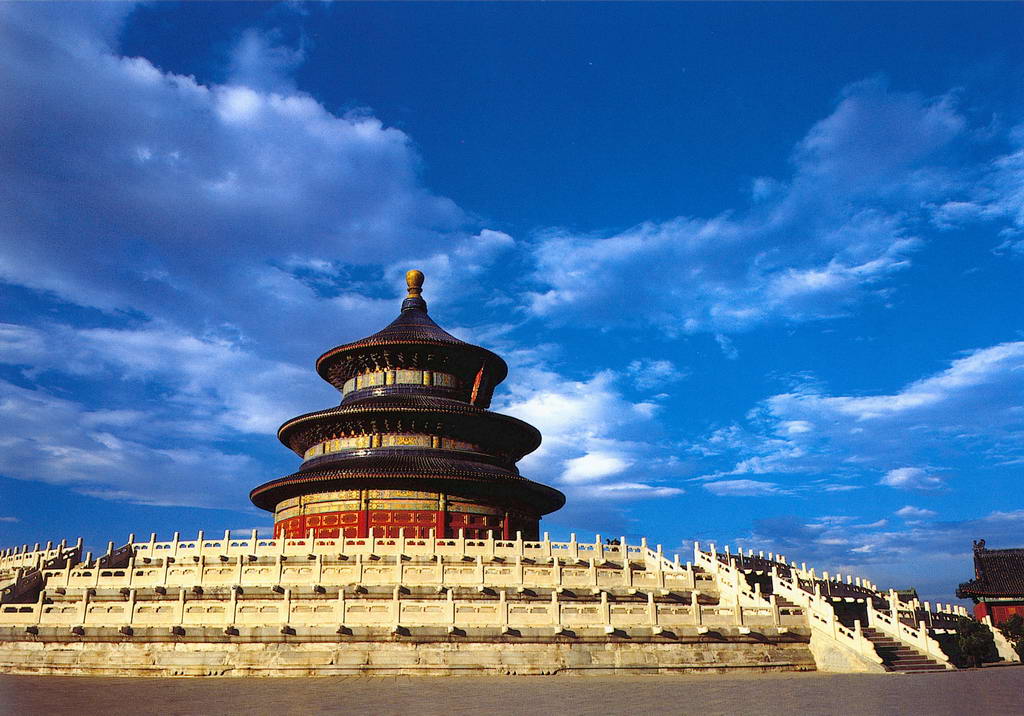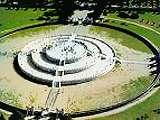 The Temple of Heaven (also Tiantan Park) is the grandest cult architecture
complex in the world and a masterpiece of the Chinese people created in ancient
times. It covers 2,700,000 square meters (667 acres), which is nearly four times
the area of the Forbidden City. The temple was constructed in 1420 during the
Ming Dynasty (1368-1644), and was enlarged during the Qing Dynasty (1644-1911).
Emperors of the two dynasties used to worship the heaven and pray for rich
harvests, as the feudal emperors thought they were the son of the heaven.
The Temple of Heaven (also Tiantan Park) is the grandest cult architecture
complex in the world and a masterpiece of the Chinese people created in ancient
times. It covers 2,700,000 square meters (667 acres), which is nearly four times
the area of the Forbidden City. The temple was constructed in 1420 during the
Ming Dynasty (1368-1644), and was enlarged during the Qing Dynasty (1644-1911).
Emperors of the two dynasties used to worship the heaven and pray for rich
harvests, as the feudal emperors thought they were the son of the heaven.
This complex has two parts: the inner temple and the outer temple and is
surrounded by two high walls. The two walls are elaborately constructed: the
north section of walls is semicircular while the south section is square. This
layout of walls reflects the ancient Chinese concept of the cosmogony: the sky
is round and the earth is square. The primary buildings in the temple are the
Altar of Prayer for Good Harvests in the north and Circular Mound Altar in the
south. They are lined in the central axis of the whole temple and connected by a
36-meter-long bridge. Subsidiary buildings include Imperial Vault of Heaven, the
Hall of Abstinence, a Bell Tower and relatively small halls.
Altar of Prayer for Good Harvest
 The Altar of Prayer for Good Harvest was where the emperors prayed for
favorable weather and ample harvest. The Hall of Prayer for Good Harvest, the
principle building of the altar, is thirty-eight meters (125 feet) high. It was
built on a three-tiered circular terrace which measures six meters (twenty
feet). The roof of the hall is covered with dark blue glazed tiles which
represent the color of the sky. With three circular balusters on the terrace,
the grand hall seems much loftier.
The Altar of Prayer for Good Harvest was where the emperors prayed for
favorable weather and ample harvest. The Hall of Prayer for Good Harvest, the
principle building of the altar, is thirty-eight meters (125 feet) high. It was
built on a three-tiered circular terrace which measures six meters (twenty
feet). The roof of the hall is covered with dark blue glazed tiles which
represent the color of the sky. With three circular balusters on the terrace,
the grand hall seems much loftier.
The structure of the Hall of Prayer for Good Harvest is a wonder. The
pavilion-style hall was built entirely of wood, but it has no crossbeam or
purlin inside. Twenty-eight pillars support the three-tier building, with the
four in the centers symbolizing four seasons of a year. Twelve pillars on each
side to present twelve months and twelve Shichens of a day (a unit of time used
by the ancient Chinese, one Shichen is equal to two hours).
Circular Mound Altar
 The Circular Mound Altar was where the sacrificial rite was held on the
winter solstice. It was constructed in 1530, younger than the Altar of Prayer
for Good Harvest. The Circular Mound is a three-tier round platform which was
built with bluestone. Each terrace is edged by white marble balusters. The
number of both flagstones in a circle and baluster posts is multiple of nine, as
nine represents infinity which is the characteristic of the heaven. If you stand
on the flagstone in the center and speak in a quite low voice, you will hear the
echo in 0.07 seconds.
The Circular Mound Altar was where the sacrificial rite was held on the
winter solstice. It was constructed in 1530, younger than the Altar of Prayer
for Good Harvest. The Circular Mound is a three-tier round platform which was
built with bluestone. Each terrace is edged by white marble balusters. The
number of both flagstones in a circle and baluster posts is multiple of nine, as
nine represents infinity which is the characteristic of the heaven. If you stand
on the flagstone in the center and speak in a quite low voice, you will hear the
echo in 0.07 seconds.
To the north of the Circular Mound is the Imperial Vault of Heaven in which
the tablet of God of Heaven is placed. The main hall is built to be a round
pavilion with dark blue roof symbolizing heaven. The East Assistant Hall
worships the gods of stars including the sun, the dipper, Venus, Jupiter,
Mercury, Mars and Saturn. In the West Assistant Hall, enshrined are the gods of
natural phenomenon including wind, rain, thunder and lightning. This courtyard
is encircled by a round wall with a length of 193 meters (633 feet). The wall is
the famous Echo Wall. If one whispers into the hall, another person who is
standing at the wall with a distance 100 to 200 meters (328-656 feet) can hear
the speaker clearly.
The Temple of Heaven was entered into the world cultural heritage list in
1998.